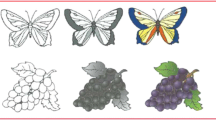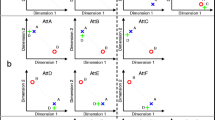Abstract
In an attempt to resolve disagreements about the events underlying repeated exposure to a stimulus and the affective consequences of these events, two experiments examined psychological complexity and response competition (two measures of the uncertainty produced by a stimulus) as related to each other and to liking and goodness of meaning ratings of Chinese characterlike stimuli. In Experiment 1, 60 undergraduates' mean latency of first free association to the stimuli (response competition) increased as a perfect monotonic function of the number of lines constituting them (psychological complexity). In Experiment 2, ratings of liking by 40 undergraduates were highest for stimuli associated with an intermediate level of uncertainty (psychological complexity and response competition). Thus it was speculated that a moderate number of stimulus exposures (reducing uncertainty to an intermediate level) is preferable to an indefinitely large number of exposures (reducing uncertainty to a minimal level). The finding of no relationship between rated goodness of stimulus meaning and uncertainty was judged to be consistent with Stang's (1974) hypothesis that characteristically observed increases in rated goodness with increasing stimulus exposures (decreasing uncertainty) are a result of subject intuitions rather than an effect of decreasing uncertainty.
Similar content being viewed by others
References
Aitken, P. P. Judgments of pleasingness and interestingness as functions of visual complexity.Journal of Experimental Psychology 1974,103 240–244.
Berlyne, D. E. Novelty, complexity, and hedonic value.Perception and Psychophysics 1970,8 279–286.
Berlyne, D. E., McDonnell, P., Nicki, R. M., & Parham, L. C. C. Effects of auditory pitch and complexity on EEG desynchronization and on verbally expressed judgments.Canadian Journal of Psychology 1967,21 346–367.
Brickman, P., Redfield, J., Harrison, A. A., & Crandall, R. Drive and predisposition as factors in attitudinal effects of mere exposure.Journal of Experimental and Social Psychology 1972,8 31–44.
Crandall, J. E., Montgomery, V. E., & Rees, W. W. “Mere” exposure versus familiarity, with implications for response competition and expectancy arousal hypotheses.Journal of General Psychology 1973,88 105–120.
Eckblad, G. The attractiveness of uncertainty.Scandinavian Journal of Psychology 1963,4 1–13.
Ferguson, G. A.Statistical analysis in psychology and education (3rd ed.). New York: McGraw-Hill, 1971.
Harrison, A. A. Response competition, frequency, exploratory behavior, and liking.Journal of Personality and Social Psychology 1968,4 363–368.
Harrison, A. A., & Zajonc, R. B. The effects of frequency and duration of exposure on response competition and affective ratings.Journal of Psychology 1970,75 163–169.
Heyduk, R. G. Rated preference for musical compositions as it relates to complexity and exposure frequency.Perception and Psychophysics 1975,17 84–91.
Kammann, R. Verbal complexity and preferences in poetry.Journal of Verbal Learning and Verbal Behavior 1966,5 536–540.
Matlin, M. W. Response competition as a mediating factor in the frequency-affect relationship.Journal of Personality and Social Psychology 1970,16 536–552.
Munsinger, H., & Kessen, W. Uncertainty, structure, and preference.Psychological Monographs, 1964,78 (9, Whole No. 586).
Smith, G. F., & Dorfman, D. D. The effect of stimulus uncertainty on the relationship between frequency of exposure and liking.Journal of Personality and Social Psychology 1975,31 150–155.
Stang, D. J. Intuition as artifact in mere exposure studies.Journal of Personality and Social Psychology 1974,30 647–653.
Stang, D. J. Effects of “mere exposure” on learning and affect.Journal of Personality and Social Psychology 1975,31 7–12.
Vitz, P. C. Preference for rates of information presented by sequences of tones.Journal of Experimental Psychology 1964,68 176–183.
Vitz, P. C. Affect as a function of stimulus variation.Journal of Experimental Psychology 1966,71 74–79.
Walker, E. L. Psychological complexity and preference: A hedgehog theory of behavior. In D. E. Berlyne & K. B. Madsen (Eds.),Pleasure, reward, preference. New York: Academic Press, 1973.
Zajonc, R. B. Attitudinal effects of mere exposure.Journal of Personality and Social Psychology, 1968,9 (Monograph supplement 2, Pt. 2).
Zajonc, R. B., Crandall, R., Kail, R. V., & Swap, W. Effect of extreme exposure frequencies on different affective ratings of stimuli.Perceptual and Motor Skills 1974,38 667–678.
Zajonc, R. B., & Rajecki, D. W. Exposure and affect: A field experiment.Psychonomic Science 1969,17 216–217.
Zajonc, R. B., Shaver, P., Tavris, C., & Van Kreveld, D. Exposure, satiation, and stimulus discriminability.Journal of Personality and Social Psychology 1972,21 270–280.
Author information
Authors and Affiliations
Rights and permissions
About this article
Cite this article
Heyduk, R.G., Bahrick, L.E. Complexity, response competition, and preference. Motiv Emot 1, 249–259 (1977). https://doi.org/10.1007/BF00998863
Issue Date:
DOI: https://doi.org/10.1007/BF00998863




